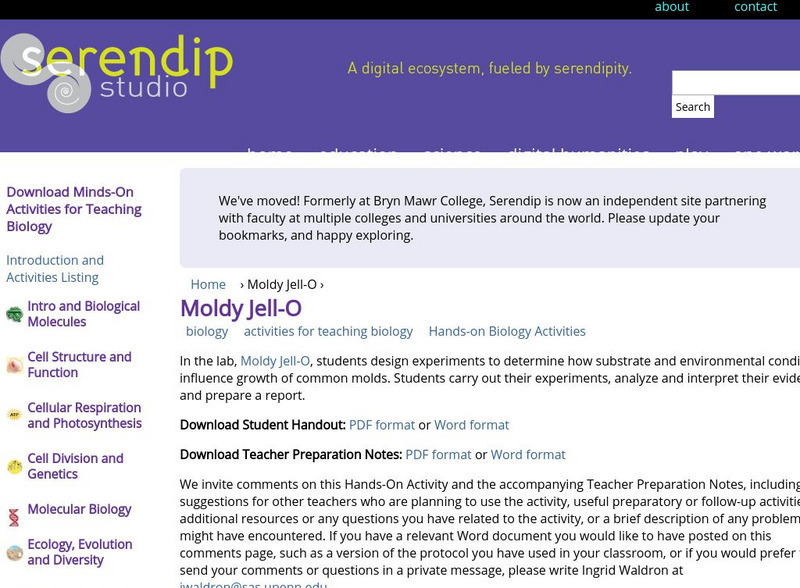Hi, what do you want to do?
Curated OER
Viewing Viruses
High schoolers view the characteristics of viruses following the 5-E learning model. By participating in discrepant events Students observe the impact of viruses over humans. By participating in discussion high schoolers examine the...
Curated OER
Plant Classification
High schoolers share with the class how they think plants are classified and are assessed on their prior knowledge. They use a packet to complete throughout the week at their own pace, which includes various activities to familiarize...
Curated OER
Plant Galls
Students study what a plant gall is and the different types that there are. For this plant lesson students examine what causes galls and how to prevent them.
Curated OER
Transmission of Disease
Students provide names of viral diseases that they would possibly like to be infected with today; listing them on the Smart Board. They then come to an agreement about what virus to use and use beakers of fluids to simulate how viruses...
Curated OER
Observing the Development of Drosophila in Apple Juice Agar
Students observe the development of the Drosophila fly. They observe the first two stages - the egg and the 3 larval instars. They observe the culture every day for 8 days using a stereo dissecting microscope.
Curated OER
The Portable Niche
Third graders, in groups, research animals, plants, and conditions found in ecosystems.
Curated OER
Optional Laboratory: Comparing Soil Temperatures In Sun and Shade
Students work together to test the temperatures of different soils in shade and sun. They make their own hypothesis before beginning the experiment. They record their data and discuss as a class.
Curated OER
Earthworms
Fifth graders research the earthworm and write a one paragraph report on its anatomy and habitat. They learn about worms and how to dissect them through Video Streaming and virtual dissections, along with actually dissect a worm as...
Curated OER
Animal Kingdom: Phylum Chordata
Students use a dichotomous key to classify various vertebrate jar speciments into classes. They examine the speciments for general characteristics of each class and fill in a corresponding chart and then complete a few final assessment...
Middle School Science
Middle School science.com: Spore Print Lab
Using this lab experiment site, your students can identify the parts of a mushroom, observe the spores released from different types of mushrooms, and understand the way fungi reproduce.
University of Missouri
Microbes in Action: Classroom Activities: A Swell Lab: Yeast Fermentation [Pdf]
This two-day experiment uses different concentrations of sugar to study the rate of fermentation. Students observe the rate of carbon dioxide gas produced by yeast to infer the rate of fermentation. Lesson plan gives a lab procedure,...
University of Missouri
Microbes in Action: Classroom Activities: Growth of Fungi on Plates [Pdf]
A science experiment to observe the growth of a colony of yeast cells. Students should also be able to observe the hyphae and mycelia structures. Lesson plan gives a background, lab procedure, teacher instructions, points for discussion,...
University of Missouri
Umsl: Microbes in Action: Classroom Activities: Fungus I [Pdf]
A science experiment to observe the rate of carbon dioxide gas produced by yeast. Students will get a visual of the process of fermentation. Lesson plan gives a lab procedure, teacher instructions, points for discussion, and additional...
Bryn Mawr College
Serendip: Moldy Jell O
Brief text summary of what students learn in the Moldy Jell-O Lab along with links to download Student Handouts and Teacher Preparation Notes in PDF or Word formats. Students design the experiment and observe the growth of mold. Focus is...















